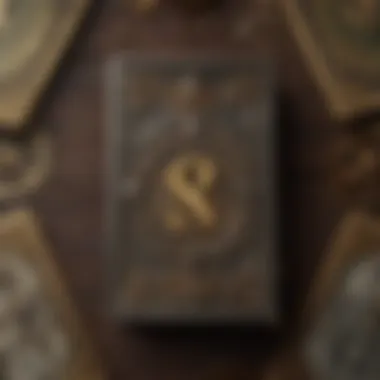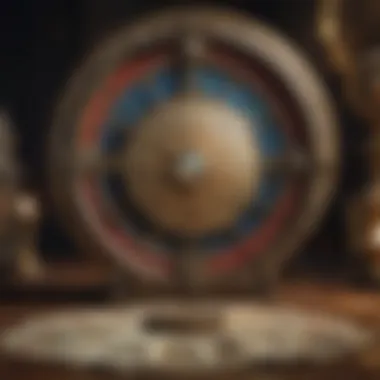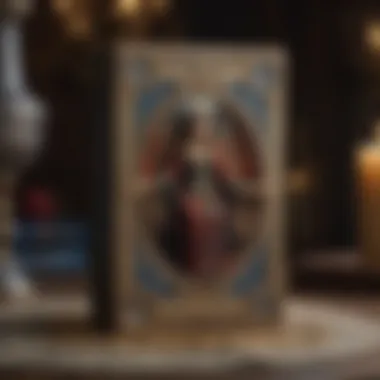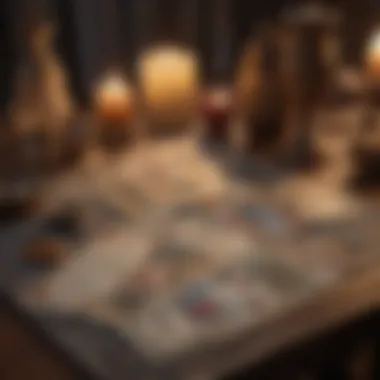Understanding Tarot Numbers: Their Significance


Intro
The relationship between tarot and numerology carries profound implications for the understanding of divination practices. This intersection offers practitioners insights that extend beyond mere card readings. In this exploration, we aim to delve into how tarot numbers infuse readings with meaning, revealing the deeper symbols and lessons encoded within each card.
Understanding the Zodiac
While the focus here is primarily on tarot numbers, it is essential to recognize the significance of the zodiac. Each tarot card resonates with specific aspects of zodiac signs. This link can enrich interpretations and foster a deeper appreciation of the intricate makeup of a tarot reading.
Overview of Zodiac Signs
The twelve zodiac signs act as archetypes that contribute to the overarching themes in both astrology and tarot. These signs embody various traits, representing distinct characteristics that can relate to the nuances of specific tarot cards. For example, Aries's assertiveness might correlate with cards that represent action and initiative.
Sign Traits and Characteristics
Understanding the traits associated with each zodiac sign enhances the context within tarot readings.
- Aries: Leadership, courage, and impulsiveness.
- Taurus: Stability, sensuality, and determination.
- Gemini: Curiosity, adaptability, and enlightenment.
- Cancer: Emotion, intuition, and nurturing.
- Leo: Creativity, confidence, and passion.
- Virgo: Precision, service, and analytical thinking.
This framework helps to illuminate the character traits that might emerge in a tarot reading, guided by the signs' influences.
Elemental Qualities
Each sign is connected to an elemental quality—Fire, Earth, Air, and Water. Recognizing these elemental connections can enhance tarot interpretations:
- Fire (Aries, Leo, Sagittarius): Passion and action.
- Earth (Taurus, Virgo, Capricorn): Practicality and materialism.
- Air (Gemini, Libra, Aquarius): Intellect and communication.
- Water (Cancer, Scorpio, Pisces): Emotion and intuition.
The elemental aspects serve as a backdrop for understanding how tarot cards convey messages that resonate with the intuitions and experiences of the querent.
The Role of Numbers in Tarot
Every tarot card is numbered, and these numbers are imbued with significant meanings drawn from numerology. Understanding these meanings can shape interpretations and influence readings.
"Numbers in tarot serve as gateways to deeper insights and connections, bridging the tangible and the metaphysical."
Major Arcana Numbers
The Major Arcana cards are numbered from 0 to 21, all hold strong symbolic meanings that can guide the querent's path. For instance:
- The Fool (0): New beginnings, innocence, and spontaneity.
- The Magician (1): Manifestation, resourcefulness, and power.
- The High Priestess (2): Intuition, wisdom, and mystery.
These numbers transcend their face values, each offering layers of interpretation that speak to the existential themes presented throughout tarot readings.
Minor Arcana Numbers
In the Minor Arcana, numbers from 1 to 10 in each suit reflect different aspects of daily experiences. For example:
- Ace (1): Beginnings, potential, and opportunities.
- Five (5): Conflict, change, and challenges.
- Ten (10): Completion, fulfillment, and attainment.
Understanding how these numbers interact in readings help practitioners frame the narrative behind the cards drawn.
Integrating Numbers in Readings
Incorporating numerology into tarot practice can elevate a reading from basic card interpretation to a profound analysis. Here are some practical tips to integrate numbers:
- Identify Key Numbers: Focus on the numbers of the drawn cards.
- Consider Their Meanings: Reflect on the numerological meanings associated with each.
- Look for Patterns: Seek recurring numbers across readings, which may indicate significant messages.


By merging the numerical symbolism with tarot, practitioners can uncover layers of meaning that enhance the querent's journey of self-discovery and understanding.
Prolusion to Tarot and Numerology
Tarot and numerology share a complex relationship that many practitioners find enlightening. Understanding this connection can enrich one’s tarot reading experience significantly. Tarot, traditionally seen as a tool for insight into one’s life, is deeply intertwined with the principles of numerology. Each card holds numerical significance that resonates with a broader symbolic meaning. This duality offers insights into the cards beyond their visual imagery, emphasizing the importance of numbers in tarot readings.
The Intersection of Tarot and Numerology
The integration of tarot and numerology creates a multifaceted approach to divination. Each number in tarot manifests unique energy and vibrations. For instance, the number three is often linked with creativity and expression, while seven embodies reflection and introspection. This symbiosis between the two disciplines allows for a deeper understanding of personal circumstances and challenges. Practitioners can analyze how these numbers influence the tarot cards drawn during a reading.
In contemporary practices, many astrologers and tarologists incorporate numerological calculations into their readings. Through analyzing life path numbers, for instance, a reader can tailor their interpretation to resonate personally with the querent. This method enhances clarity and relevance in readings, providing insight that purely visual interpretations may overlook.
Historical Context of Numerology
The roots of numerology extend back through history, appearing in various cultures and spiritual practices. Ancient civilizations like the Babylonians and Egyptians integrated numbers into their understanding of the cosmos, making significant contributions to early numerological frameworks. Pythagoras, a pivotal figure in this field, believed mathematics was the language of the universe. His concepts profoundly influenced how numbers are perceived, paving the way for modern numerology.
Over centuries, different traditions have interwoven numerology with esoteric practices, including tarot. The meaning attributed to numbers in numerology often parallels the interpretations of tarot cards. This historical backdrop provides rich context for understanding the significance of numbers in tarot today. Practitioners can trace back to these historical insights to guide their readings, adding depth to their interpretations.
Understanding the historical context of numerology offers valuable insights into how numbers function within tarot.
In summary, the study of tarot numbers through the lens of numerology unveils layers of meaning that can transform a reading from a simple prediction into a profound exploration of one's life path. As readers engage with this content, they will gather tools to enhance their tarot practices.
The Role of Numbers in Tarot
In tarot, numbers hold a crucial role. They are not mere representations; rather, they embody deeper meanings that influence interpretations and readings. Each number corresponds to specific energies, patterns, and insights, greatly enriching the practice of tarot reading.
Understanding how numbers operate within tarot can enhance a reader's ability to decipher messages from the cards. This exploration allows practitioners to connect not just with the symbols but also with the numerological significance behind them. It provides a framework for understanding the cycles of life, emotions, and experiences reflected in the cards. The role of numbers becomes pivotal in drawing connections between different cards, enhancing an overall reading.
Understanding Tarot Structure
Tarot cards are categorized into two main sections: the Major Arcana and the Minor Arcana. The structure is designed intentionally to illustrate different aspects of the human experience and life's journey.
- Major Arcana consists of 22 cards, each representing significant life themes and spiritual lessons.
- Minor Arcana, on the other hand, is divided into four suits: Cups, Wands, Swords, and Pentacles, covering more day-to-day aspects of life.
Numbers play a vital role here, as they are integral to both these categories. Each card has an associated number that contributes to its meaning and how it should be interpreted in a reading.
Major Arcana and Their Numerical Significance
The Major Arcana cards are numbered from 0 to 21. Each number signifies not only the stage of the journey but also resonates with specific archetypal themes.
For instance, the Fool, numbered 0, represents new beginnings and the potential for growth. The Magician, numbered I, embodies skill and resourcefulness. Continuing through the series, these numbers illustrate a path through self-discovery and enlightenment.
In this context, each Major Arcana card becomes a symbol of significant life events or conditions that a person may encounter. Their numerical significance thus enhances understanding and adds layers to interpretations.
Minor Arcana: Numbering and Meaning
The Minor Arcana consists of 56 cards, and they are further subdivided into the four suits just mentioned. Each suit is composed of 14 cards: Ace through 10, plus four court cards. The numbers in the Minor Arcana provide insights into specific energies and situations.
For example:
- Aces signify new beginnings or opportunities.
- Twos often indicate choices or partnerships.
- Threes suggest creativity and collaboration.
As we progress through to ten, the energies transform from pure potential at the Ace level to completions at ten. Understanding how these numerical meanings interlink can significantly impact readings.
"Every number in tarot tells a story, reflecting universal truths and guiding personal insights."


By integrating this understanding of numbers into personal practices, tarot readers can deepen their connection to the cards and enhance their interpretations, fostering a comprehensive approach to tarot reading.
Symbolic Meanings of Tarot Numbers
Understanding the symbolic meanings of tarot numbers is central to interpreting tarot readings. Each number carries distinct energies and qualities that can deepen one's insight during a reading. Recognizing these meanings allows readers to unlock layers of significance within the cards, providing a more nuanced understanding of the messages conveyed. In this section, we will explore the meanings associated with numbers from one to ten in tarot, addressing how they influence not only individual cards but also overall readings.
One: The Beginning and Unity
The number one embodies the concept of beginnings. It symbolizes unity and the onset of new ventures. This number often appears in tarot to indicate the start of a journey or an idea. When the Ace card appears, it typically signifies potential and possibilities. The energy of one suggests independence and self-reliance. It prompts contemplation about personal aspirations and the necessity of taking the first steps towards goals.
Two: Duality and Relationships
Two denotes duality and the importance of relationships. It reflects the balance between opposing forces and the dynamics of partnerships. In tarot, the two of cups is a prime example, representing emotional connections and mutual respect in relationships. This number encourages consideration of harmony and teamwork. When this number arises, it invites the question of how one interacts with others and whether balance is maintained in personal or professional spheres.
Three: Creativity and Expression
Three is the number that signifies creativity and expression. It resonates with growth and expansion, often reflecting the collaborative efforts of individuals. In tarot cards like the three of pentacles, we see the union of talents coming together to create something meaningful. As this number arises in a reading, it encourages engaging in creative pursuits and valuing the expression of one's authentic self.
Four: Stability and Structure
Four symbolizes stability and structure. It represents the solid foundation necessary for growth and development. Tarot cards such as the four of wands illustrate the importance of home and community. This number often suggests the need for order and discipline in achieving goals. A reading that features four can indicate a time to focus on establishing stability in various aspects of life.
Five: Change and Challenge
Five indicates change and challenge. It often appears in readings when one is facing obstacles or transitions. The five of swords, for example, brings attention to conflicts and the need for resolution. This number embodies the idea of adaptability; it urges individuals to embrace change, even when it is uncomfortable. It might serve as a reminder of the necessity to confront challenges for growth.
Six: Harmony and Balance
Six reflects harmony and balance, often indicating resolution and cooperation. In tarot interpretations, this number suggests that efforts toward peace and collaboration are recognized and rewarded. The six of cups, for instance, emphasizes nostalgia and fond memories, suggesting that past experiences help guide current situations. When this number emerges, it calls for a reassessment of relationships to maintain equilibrium.
Seven: Reflection and Introspection
Seven evokes reflection and introspection. It often indicates a need to pause and examine one's thoughts and feelings. The seven of pentacles signifies patience and contemplation regarding investments in time or resources. This number encourages thorough consideration of motivations and decisions, pointing towards a deeper understanding of oneself. A reading with seven may prompt an exploration of inner thoughts and intuition.
Eight: Power and Strength
Eight symbolizes power and strength. It indicates control over one's circumstances and the ability to manifest desires. The eight of swords, for example, often highlights feelings of entrapment but reminds us that the power to overcome challenges lies within. When this number arises, it may suggest an emphasis on personal empowerment and determination to face life's difficulties.
Nine: Completion and Fulfillment
Nine embodies the themes of completion and fulfillment. It often signifies the nearing realization of goals. The nine of cups, commonly known as the wish card, reflects contentment and satisfaction in what one has achieved. This number invites individuals to recognize the fruits of their labor and to celebrate accomplishments. A reading featuring nine urges a reflection on what has been learned and how far one has come.
Ten: Cycles and New Beginnings
Ten represents cycles and new beginnings. It symbolizes the closing of one chapter and the potential for a new start. The ten of swords illustrates this concept vividly, suggesting that endings are often necessary for new opportunities. When this number appears, it speaks to the importance of acknowledging transitions and embracing the potential that lies ahead. It serves as a reminder that life is a continuous cycle of starts and endings, and each ending can lead to a fresh beginning.
Numerological Calculations in Tarot
The realm of Tarot is not just restricted to the cards themselves but extends into a broader system of numerological calculations. Understanding numerological calculations enhances the interpretative depth of tarot readings. When tarot practitioners engage with numbers, they open a pathway to a more profound understanding of the messages conveyed through the cards.
Numbers hold the potential to reveal hidden insights, guiding readers in how to perceive the cards during a reading. By calculating personal numbers, such as Life Path Numbers, a reader can align their interpretations with the very essence of an individual’s journey. This practice adds layers of meaning to each card that is drawn, allowing for a more personalized reading experience.
Several key benefits stem from integrating numerological calculations into Tarot practice:
- Deeper Insights: Numerological calculations help unveil core themes in a person's life, which can clarify the significance of the tarot cards when they appear in readings.
- Personalization: Engaging with personal numbers offers a tailored approach to readings, making them more relevant for the individual involved.
- Interconnectedness: The intertwined nature of numbers and their symbolic meanings fosters a holistic approach to tarot, where every element contributes to the overall reading.


Life Path Numbers and Tarot Interpretations
Life Path Numbers are a significant aspect of numerology that can deeply influence tarot interpretations. Each individual's Life Path Number is derived from their birth date, creating a unique number that signifies their personality traits, challenges, and potential life direction.
When interpreting tarot cards, understanding the corresponding Life Path Number provides valuable context. For instance, if a card reflects themes of leadership, a reader may consider how this ties into someone’s Life Path Number, suggesting opportunities for growth or warning against potential obstacles.
"Incorporating Life Path Numbers into tarot readings allows practitioners to offer insights that resonate at a personal level."
It is important to consider how the Life Path Number interacts with the energies of the cards. This interaction can indicate whether a card’s message aligns with a person’s trajectory or suggests a departure from their current path. The reader may find it useful to analyze these connections to enhance the overall significance of the reading.
Using Personal Numbers for Readings
Beyond Life Path Numbers, various personal numbers can be utilized in readings. Examples include Expression Numbers or Soul Urge Numbers. Each of these numbers offers distinct insights that can further clarify the meanings of the tarot cards drawn.
By employing these personal numbers, readers can establish a nuanced understanding of the tarot's implications for an individual's personal life, relationships, and future prospects.
Some guiding points for using personal numbers in readings are:
- Identifying Themes: Recognize how specific numbers resonate with the themes presented in the tarot cards.
- Personal Reflection: Encourage individuals to reflect on how their personal numbers align with their experiences and current situations, creating a dialogue during the reading.
- Integrating Knowledge: Synthesize the meanings derived from personal numbers alongside standard tarot interpretations to create a more comprehensive reading.
Through thoughtful integration of numerological calculations, tarot practitioners elevate the art of divination. This synergy enables a richer, more impactful connection between the cards and the individuals they are meant to serve.
Integrating Tarot Numbers into Readings
Integrating numbers into tarot readings is a vital aspect for practitioners who seek deeper insights. In the world of tarot, each card embodies unique energies, and numbers serve as a tool to amplify these energies. Understanding how to weave numerical significance into readings enhances interpretative clarity. This integration allows readers to move beyond surface meanings, delving into layers of wisdom that numbers provide.
When focusing on integrating tarot numbers, several factors need consideration:
- Numerical Patterns: Recognizing recurring numbers across the tarot spread can reveal underlying themes in readings. For example, a spread that has multiple cards representing the number seven might indicate a period of contemplation or spiritual growth.
- Symbolic Meanings: Each number holds intrinsic meanings. For instance, the number two often reflects duality and partnership, influencing how one interprets cards like The Lovers or Two of Cups.
- Personal Numerology: Integrating personal numbers can personalize readings, allowing a connection between the reader’s own life path and the cards drawn. This practice makes the session relevant and resonates more deeply.
Practical Applications of Numbers in Tarot
Utilizing numbers in practical tarot applications requires both an understanding of the inherent meanings and an intuitive approach. Here are specific methods to apply this knowledge effectively:
- Charting Tarot Spread: While creating a spread, consider assigning specific numerical values to positions. For example, if a position represents the past, one might refer to the Four card structure of stability to provide context for past actions affecting the present.
- Card Sequence Analysis: Analyze the sequence of drawn cards. Numbers can help identify influences or energies that might be accumulating within the reading.
- Numerical Significance in Question: Tailor the reading based on the question posed. If a querent seeks insights regarding personal growth, emphasize numbers like six, which symbolize harmony, and three, which indicates creativity and expression.
By implementing these strategies, readers can create multi-dimensional readings that resonate on several levels.
Enhancing Interpretations with Numerical Insights
Numerical insights elevate the interpretative process in tarot readings. This enhancement occurs through:
- Deepening Context: Numbers provide context for understanding cards. For instance, if a querent draws a Seven of Swords alongside a numeric pattern indicative of strategy, the interpretation shifts from mere deceit to calculated maneuvering.
- Guiding Action Steps: They can offer action-oriented guidance. Drawing the number five frequently may signify challenge; hence, readings can suggest ways to navigate difficulties.
- Harmonizing Messages: Numbers help harmonize messages across different cards. When various cards display a cohesive numerical theme, it effectively unifies the reading, providing clarity and direction.
As tarot readers become adept at integrating numbers into their practice, readings transform into profound journeys of discovery. This practice not only enriches the experience for the practitioner but also for the querent, creating a fulfilling bond that resonates deeply with the energies at play.
Integrating numbers into tarot readings is not merely a practice; it is an art that unveils the profound connections inherent in the universe.
Culmination: The Synergy of Tarot and Numerology
In exploring the connection between tarot and numerology, one discovers a deep synergy that enriches both practices. Understanding tarot numbers is more than just a numerical representation; they provide layers of meaning that enhance readings and interpretations. The interaction between tarot cards and their corresponding numbers aids in drawing out insights that may be overlooked when considering the cards in isolation.
This synergy is important because it offers practitioners a more detailed framework to interpret the symbols of the tarot. By integrating numerology into tarot practice, readers can gain a multi-dimensional perspective. Each number carries its own energy, influences, and meanings, which interact with the card imagery and themes. For instance, the number three often denotes creativity, while six symbolically leans towards harmony. Thus, acknowledging these nuances can lead to more profound revelations during a reading.
Benefits of Synergizing Tarot and Numerology
- Enhanced Interpretations: By understanding how numbers influence card meanings, readers can provide more accurate and relevant readings.
- Personalized Insights: Numerology adds layers that relate specifically to the individual seeker, making sessions feel more tailored.
- Broadening Perspective: Each reading can touch on various life aspects, making the experience holistic.
However, integrating these systems requires careful consideration. Practitioners must be mindful of their own biases and limitations. One must strive to remain open to the messages being conveyed through the cards and numbers alike. This journey of understanding does not stop at mastery; it is an ongoing pursuit that requires curiosity and a willingness to explore further complications of each system.
"Incorporating numerology into tarot is not merely an addition; it transforms the very essence of how we interpret the world through these cards."
Ultimately, this exploration is a continuous journey. As practitioners delve deeper into both tarot and numerology, they can find richer connections to themselves and others.







